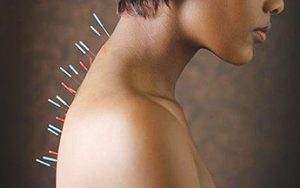by Victoria A. Liotta, DAc, LMT
Bell’s palsy can be quite alarming to those that contract the condition due to its sudden, unexplained and

unsightly nature. It presents as a paralysis of one side of the face, characterized by the inability to close the eye and smile fully. The paralysis of the facial muscles causes asymmetry and “drooping” of the affected side. It is also common to have pain behind the ear before the onset of visible symptoms.
The nerve affected by Bell’s palsy is the facial nerve, aka “cranial nerve seven” (CNVII). There is no definitive diagnostic test for Bell’s palsy; therefore, it is diagnosed by excluding other pathologies affecting CNVII. Although the condition is mysterious in nature, its biomedical origins can be viral or due to being immunocompromised. Conditions such as herpes simplex virus, herpes zoster (shingles), tumors, Lyme disease and bone fractures can give rise to facial paralysis and should be ruled out. MRIs (magnetic resonance imaging tests) and CTs (computed tomography scans) may be used to test for tumors, fractures and stroke, while blood tests can rule out Lyme disease.
Bell’s palsy is treated primarily with corticosteroids and/or antiviral medications prescribed by a physician. The condition can resolve fully with or without treatment within six months, but corticosteroids, antiviral medications, along with adjunct therapies, such as acupuncture, help shorten recovery time. The key to an abbreviated recovery time is early intervention.
If someone is experiencing symptoms of Bell’s palsy, it is recommended to seek medical attention immediately and begin acupuncture shortly after for best results. Acupuncturists take a different approach to treating disease, as they look for imbalances in the body. Many imbalances are caused by the natural elements, such as wind, cold, damp or heat. Wind is a conduit for pathogens and often combines with cold, as seen in the common cold and flu. Acupuncture describes this pattern as an invasion of wind-cold. Bell’s palsy is a deeper manifestation of wind-cold specific to the face. Wind makes its entrance into the body at the posterior neck and base of the skull, which is why acupuncturists recommend wearing a scarf during the cold, windy seasons. It is notable that in acupuncture and Chinese medicine, the base of the skull houses several areas with the word “feng,” meaning “wind,” in their title. Acupuncturists stimulate these areas, known as points, in addition to the affected site to resolve Bell’s palsy.

Victoria A. Liotta
Early intervention is key. A 2015 systematic review and meta-analysis published by Li, Qui & Qin found favorable results of acupuncture’s ability to resolve Bell’s palsy; however, the combination of prescriptive medications with acupuncture is most recommended.
Victoria A. Liotta, DAc, LAc, LMT, is a doctor of acupuncture at Inner Source Health. As an acupuncturist and massage therapist, she has experience treating headaches and body pain. In addition, she frequently treats people with anxiety and depression. For more information, call 631-421-1848 or visit InnerSourceHealth.com.





